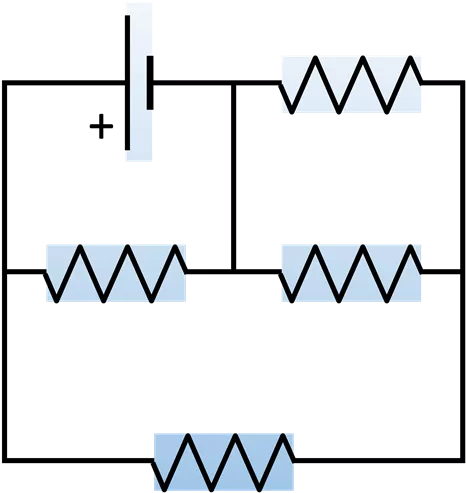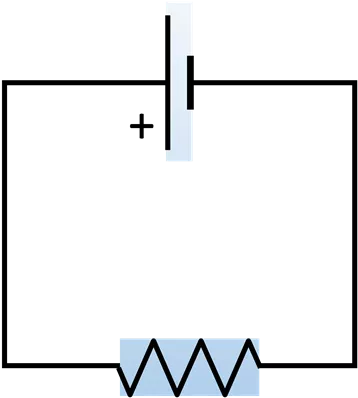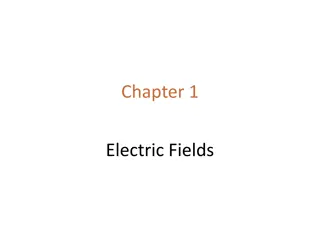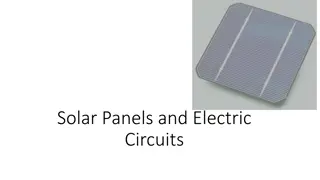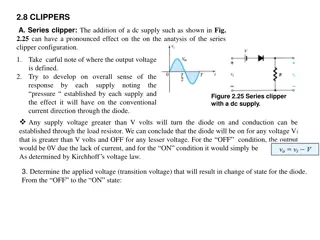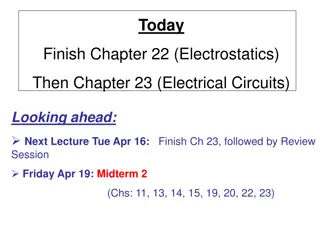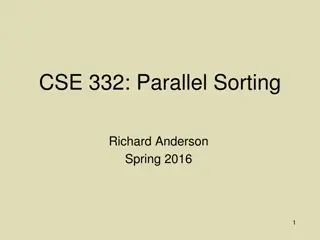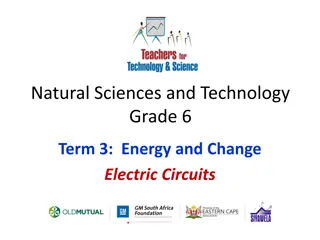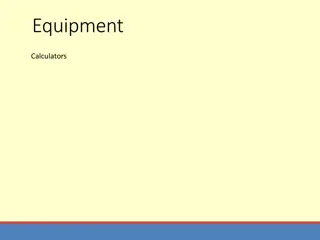Electric Circuits: Series and Parallel Configurations Explained
In this lecture on electric circuits, we delve into series and parallel circuits featuring batteries, wires, resistors, and capacitors. Key concepts discussed include Kirchhoff's loop rule, series components, and equivalent resistance and capacitance. Learn how to simplify complex circuits and analyze voltages in series and parallel setups.
Download Presentation

Please find below an Image/Link to download the presentation.
The content on the website is provided AS IS for your information and personal use only. It may not be sold, licensed, or shared on other websites without obtaining consent from the author. Download presentation by click this link. If you encounter any issues during the download, it is possible that the publisher has removed the file from their server.
E N D
Presentation Transcript
Phys 102 Lecture 7 Series and parallel circuits 1
Today we will... Learn about electric circuits Circuits with a battery, wires, and resistors Circuits with a battery, wires, and capacitors Analyze circuits Take a complex-looking circuit like... ...and turn into a simple-looking circuit like + + Phys. 102, Lecture 7, Slide 2
Recall from last time... Electric potential difference across circuit element is its voltage Velement Should be V , but we ll usually drop the + R C Batteries pump charges Provide emf for charges Resistors regulate current Dissipate power Capacitors store charge Store energy = Q C V = = battery V V IR C R Circuits connect elements with wires, which we treat as ideal conductors Phys. 102, Lecture 7, Slide 3
Kirchhoff loop rule A charge making a complete loop around a circuit must return to the same electric potential ( height ) at which it started Resistor R (bumpy hill) + VR R + Battery (pump) = 0 V Sum of electric potential differences (voltages) around circuit loop is zero Phys. 102, Lecture 7, Slide 4
Series components Two components are said to be in series when they are connected end-to-end by a single wire I1 R1 V1 R1 + I2 R2 V2 R2 Phys. 102, Lecture 7, Slide 5
ACT: CheckPoint 1.2 Consider a circuit with two resistors R1 and R2 in series. Compare the voltages across the resistors: R1 = 1 + R2 = 10 A. V1 > V2 B. V1 = V2 C. V1 < V2
ACT: Capacitors in series Consider a circuit with two capacitors C1 and C2 in series. Compare the voltages across the capacitors: C1 = 1 F + C2 = 10 F A. V1 > V2 B. V1 = V2 C. V1 < V2 Phys. 102, Lecture 7, Slide 7
Equivalent resistance & capacitance Circuit behaves the same as if series components were replaced by a single, equivalent component Resistors Capacitors C1 C2 Ceq R1 R2 Req I1 I2 Ieq Q1 Q1 Q2 Q2 Qeq Qeq = = V1 V2 Veq V1 V2 Veq = = + = = = = + I I I V V V Q Q Q V V V 1 2 1 2 1 2 1 2 eq eq eq eq 1 1 C 1 = + = + R R R 1 2 eq C C 1 2 eq Phys. 102, Lecture 7, Slide 8
Calculation: vascular resistance The circulatory system is analogous to an electric circuit Pressure difference Blood flow Vascular resistance emf Electric current Electrical resistance The circulatory system consists of different types of vessels in series with different resistances to flow heart= 120 V* Vein Venule Capillary Arteriole Artery RV = 4 Rv= 6 Rc= 20 Ra= 50 RA = 20 *Numbers represent accurate relative values Phys. 102, Lecture 7, Slide 9
Calculation: vascular resistance Calculate the current I through the vascular circuit and the voltages across the different types of vessels heart= 120 V heart Simplify Vein Venule Capillary Arteriole Artery Expand RV = 4 Rv= 6 Rc= 20 Ra = 50 RA = 20 Req Phys. 102, Lecture 7, Slide 10
Kirchhoff junction rule Charges flowing through a junction split. By conservation of charge, the sum of currents into a junction equals the sum of currents out of a junction I2 I2 I1 + + I3 + + + + + Junction I3 I1 = I I in out Phys. 102, Lecture 7, Slide 11
Parallel components Components are said to be in parallel when both ends are connected to each other, forming a loop containing only them I I2 I1 + V2 R1 R2 V1 I1 I I2 Phys. 102, Lecture 7, Slide 12
ACT: Parallel or series? C2 Consider the circuit to the right. Which of the following statements is true? + C1 C4 C3 A. C1 & C4 are in series B. C2 & C4 are in parallel C. C1 & C3 are in parallel Phys. 102, Lecture 7, Slide 13
ACT: Resistors in parallel Consider a circuit with two resistors R1 and R2 in parallel. Compare I1, the current through R1, to I2, the current through R2: + R1 = 1 R2 = 10 A. I1 > I2 B. I1 = I2 C. I1 < I2 Phys. 102, Lecture 7, Slide 14
ACT: CheckPoint 2.3 Now we add a switch S. What happens to the current out of the battery when the switch is closed? S + R1 R2 A. Ibattery increases B. Ibattery remains the same C. Ibattery decreases DEMO Phys. 102, Lecture 7, Slide 15
Equivalent resistance & capacitance Circuit behaves the same as if parallel components were replaced by a single, equivalent component Capacitors Resistors V1 V1 C1 R1 I1 Q1 Q1 Ceq Req Ieq Qeq Qeq = C2 = R2 I2 Q2 Q2 Veq Veq V2 V2 + = = = + = = = I I I V V V Q Q Q V V V 1 2 1 2 1 2 1 2 eq eq eq eq 1 1 R 1 R = + = + C C C 1 2 eq R 1 2 eq Phys. 102, Lecture 7, Slide 16
Calculation: vascular resistance In previous calculation, capillaric resistance accounts for ~20% of total vascular resistance, yet capillaries are the thinnest blood vessels, and should have the highest resistance. Why? Vein Artery Venule Arteriole Capillary Phys. 102, Lecture 7, Slide 17
Calculation: cardiovascular system The human cardiovascular system consists of two circuits: pulmonary circulation which carries blood though the lungs, and systemic circulation which carries blood to the organs Rbrain The organs of the body are connected in parallel in the systemic circuit Rpulm Simple circuit model*: Rpulm = 12 , Rbrain = 1 k , Rbody = 160 , heart = 120 V + heart *Numbers represent accurate relative values Rbody Calculate current through each component of circulatory system Phys. 102, Lecture 7, Slide 18
ACT: analyzing circuits Which of the following circuit is different than the others? I II III + + + A. Circuit I B. Circuit II C. Circuit III D. All three are equivalent E. All three are different Phys. 102, Lecture 7, Slide 19
Calculation: circulatory system Calculate current through each component of circulatory system Rpulm = 12 , Rbrain = 1 k , Rbody = 160 , heart = 120 V Rpulm Rpulm Simplify Simplify heart heart heart + + + Rbody Rsyst Rtot Rbrain Rbrain & Rbody are in parallel 1 1 R R R = = syst brain body V V V = + syst brain body I I I Rpulm & Rsyst are in series 1 = + = + R R R tot pulm syst syst brain body = + = V pulm V = pulm I syst V = I tot heart heart I syst Phys. 102, Lecture 7, Slide 20
Calculation: circulatory system Calculate current through each component of circulatory system Rpulm = 12 , Rbrain = 1 k , Rbody = 160 , heart = 120 V Rpulm Expand heart heart + + Rtot Rsyst Rpulm & Rsyst are in series = + tot pulm R R R syst = + = V pulm V syst V tot heart = = I I heart I pulm syst Phys. 102, Lecture 7, Slide 21
Calculation: circulatory system Calculate current through each component of circulatory system Rpulm = 12 , Rbrain = 1 k , Rbody = 160 , heart = 120 V Rpulm Rpulm Expand Expand heart heart heart + + + Rbody Rbrain Rtot Rsyst Rbrain & Rbody are in parallel 1 1 R R R 1 = + syst brain body = = syst V brain V body V = + I brain I body I syst Phys. 102, Lecture 7, Slide 22
Summary of todays lecture Two basic principles: Kirchhoff loop rule Voltages around circuit loop sum to zero (based on conservation of energy) = 0 V Kirchhoff junction rule Currents into a circuit branch equal currents out (based on conservation of charge) = I I in out Phys. 102, Lecture 7, Slide 23
Summary of todays lecture Series components Currents are the same Voltages add Resistors = = I I I 1 2 eq = + V V V 1 2 eq R 1 1 C 1 = + = + R R 2 Capacitors 1 eq C C 1 2 eq Parallel components = = V V V Voltages are the same Currents add Resistors R 1 2 eq = + 1 I I I 1 2 eq 1 1 R = + C C C = + R Capacitors 1 2 eq 1 2 eq Don t mix equations! Phys. 102, Lecture 7, Slide 24




